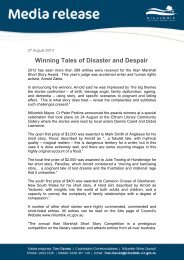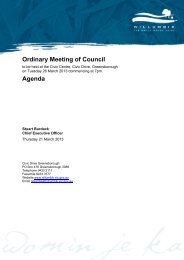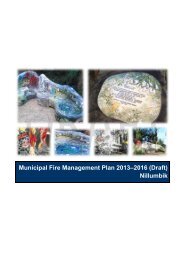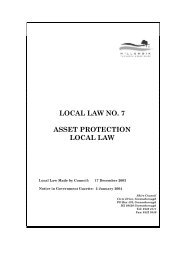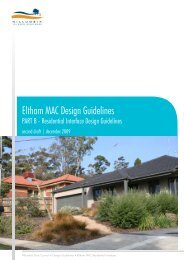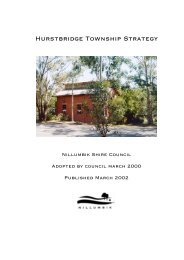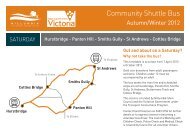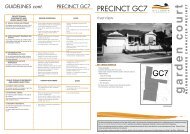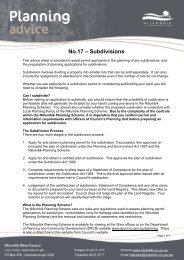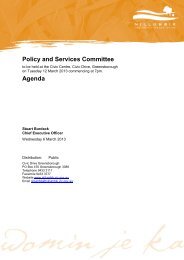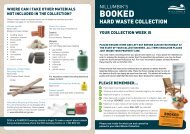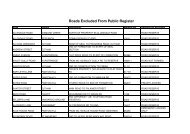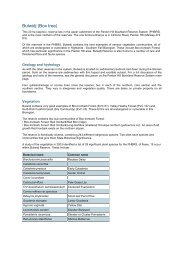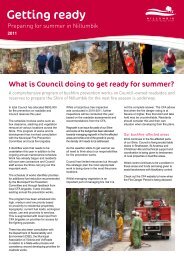Sustainable Water Management Plan - Nillumbik Shire Council
Sustainable Water Management Plan - Nillumbik Shire Council
Sustainable Water Management Plan - Nillumbik Shire Council
You also want an ePaper? Increase the reach of your titles
YUMPU automatically turns print PDFs into web optimized ePapers that Google loves.
Theme 1: <strong>Water</strong> conservation<br />
Background<br />
Although Australia is the driest inhabited continent<br />
on earth, it also has one of the highest rates of water<br />
use per capita in the world. In order to preserve a<br />
sustainable supply of good quality drinking water for<br />
future generations, we need to change our current<br />
patterns of consumption by using water more<br />
efficiently and building an ethic of water conservation<br />
throughout the community.<br />
Melbourne has been experiencing drought since<br />
1998 and changes in weather pattern forecasts<br />
predict warmer temperatures, increases in<br />
evaporation rates and lower rainfall averages. While<br />
there is still uncertainty as to the specific implications<br />
of global warming on regional rainfall, it is likely that<br />
Victoria will have less water available for future uses.<br />
Melbourne has experienced Stage 1, 2, 3 and 3a<br />
water restrictions and permanent water saving<br />
measures are now mandatory. For the first time ever,<br />
Melburnians are not able to use water in the same<br />
capacity as they have previously done. Without<br />
further water conservation measures, Melbourne<br />
could experience a water supply shortfall within the<br />
next 15 years. 3 If the most severe climate change<br />
scenarios occur, this shortfall could happen even<br />
sooner. Although this does not mean Melbourne will<br />
run out of water, the supply would be diminished and<br />
the frequency or severity of water restrictions would<br />
increase. The Victorian government has introduced<br />
a target to reduce Victoria’s potable water use by<br />
15% by 2010, and has stated that building a new<br />
dam to increase Melbourne’s water supply is not<br />
a sustainable solution. The importance of using<br />
water efficiently is vital if Melbourne’s supply is to be<br />
reliable for future generations. At the time of writing<br />
this <strong>Plan</strong>, Melbourne’s water storages were at a<br />
capacity of 40.3%. 5<br />
A wide range of water conservation options are<br />
available to <strong>Council</strong> and the community. There<br />
are both financial and environmental benefits from<br />
using water efficiently. Education plays an important<br />
role in assisting the implementation of <strong>Council</strong>’s<br />
<strong>Sustainable</strong> <strong>Water</strong> <strong>Management</strong> <strong>Plan</strong>. Promotion<br />
of water saving devices and appliances will bring<br />
water conservation to the forefront for <strong>Council</strong>, the<br />
community and contractors. It is also important that<br />
the community is informed of <strong>Council</strong>’s work to<br />
improve water conservation across <strong>Council</strong> facilities.<br />
The community should be aware of <strong>Council</strong>s’ water<br />
consumption reduction goal and progress toward<br />
achieving it. A <strong>Council</strong> that practices smart water use<br />
in its daily activities will then provide a solid basis on<br />
which to promote water conservation to the broader<br />
community.<br />
<strong>Water</strong> conservation initiatives that are<br />
considered in the <strong>Plan</strong> include:<br />
<strong>Water</strong> efficient appliances<br />
Upgrading, replacing and/or retrofitting existing<br />
<strong>Council</strong> facilities. <strong>Water</strong> efficient appliances that will<br />
be considered include:<br />
• dual flush toilets<br />
• flow control valves<br />
• AAA (or higher) rated showerheads<br />
• AAA (or higher) rated dishwashers<br />
• sensor switches<br />
• waterless urinals<br />
• spring-loaded taps<br />
• rainwater tanks.<br />
Rainwater harvesting and reuse<br />
To make better use of stormwater, rainwater tanks<br />
can capture and store runoff as a substitute for<br />
potable water supply where alternative water supply<br />
alternatives are appropriate for toilet flushing and<br />
irrigation.<br />
Stormwater harvesting and reuse<br />
Stormwater harvesting directly from stormwater<br />
drains for capture in tanks, is often appropriate<br />
for water intensive applications such as irrigation<br />
of sports grounds, where buildings are not<br />
appropriately located for rainwater harvesting.<br />
Greywater reuse<br />
Wastewater can be captured and reused for<br />
gardening or toilet flushing. As greywater is not<br />
suitable for direct human contact, care must be taken<br />
to ensure that this water does not contaminate the<br />
potable water supply or impact on the environment.<br />
Blackwater<br />
Sewage treated to an appropriate standard may be<br />
used in a range of applications. Sewer mains that<br />
run through the <strong>Shire</strong> of <strong>Nillumbik</strong> carry large and<br />
reliable water flows that can be used for non-drinking<br />
purposes. The use of recycled water has the dual<br />
benefit of reducing both potable water demand and<br />
the amount of discharge of treated effluent. This<br />
process is also known as sewer mining.<br />
<strong>Water</strong> sensitive urban design<br />
<strong>Water</strong> Sensitive Urban Design (WSUD) is a<br />
sustainable approach that seeks to ensure<br />
developments are carefully designed, constructed<br />
and maintained to minimise impact on the natural<br />
environment.<br />
WSUD aims to:<br />
• protect natural systems<br />
• integrate stormwater treatment into the<br />
landscape<br />
• protect water quality<br />
• reduce runoff and peak flows.<br />
Rainwater tanks form an important element of<br />
WSUD and water conservation, with the tanks acting<br />
as small retention basins in times of heavy rain,<br />
while providing reuse options for activities such as<br />
toilet flushing and irrigation.<br />
Goals<br />
Monitoring of <strong>Council</strong>’s progress will be against the<br />
2000-2001 consumption level of 186,958 kilolitres<br />
of water.<br />
<strong>Council</strong>’s Operations Centre actions are highly<br />
dependant on rainfall and therefore it is expected<br />
there will be annual variations in water consumption.<br />
However, through the retrofitting and upgrade<br />
program, <strong>Council</strong> is confident that it can reduce its<br />
total water use by 45% from 2000-2001 levels by<br />
2010-2011. This will result in a potential saving of<br />
84,130 kilolitres of water.<br />
<strong>Council</strong>’s goals for water consumption:<br />
<strong>Council</strong> goal<br />
To reduce <strong>Nillumbik</strong> <strong>Shire</strong> <strong>Council</strong>’s water<br />
consumption by 45% from 2000-2001 levels by<br />
2010-2011.<br />
Community goal<br />
To reduce the <strong>Shire</strong> of <strong>Nillumbik</strong>’s community water<br />
consumption by 25% from 2000-2001 levels by<br />
2010-2011.<br />
These goals will be reviewed by <strong>Council</strong> every three<br />
years.<br />
Strategic Objectives<br />
1. To be a leader in sustainable water<br />
management.<br />
2. To reduce water use and encourage<br />
water efficiency in all <strong>Council</strong> operations,<br />
households, businesses and schools.<br />
3. To continue to work in partnership with water<br />
retailers to develop water conservation<br />
programs.<br />
4. To increase the awareness and understanding<br />
of sustainable water use principles and<br />
practices.<br />
5. To actively seek funding for water saving<br />
programs and devices.<br />
6. To monitor and annually report on <strong>Council</strong> and<br />
the community’s water consumption levels.<br />
3<br />
Draft <strong>Water</strong> Supply-Demand Strategy for Melbourne 2006-2055 pg 1<br />
5<br />
www.melbournewater.com.au 7 November 2007<br />
12 <strong>Sustainable</strong> <strong>Water</strong> <strong>Management</strong> <strong>Plan</strong> <strong>Sustainable</strong> <strong>Water</strong> <strong>Management</strong> <strong>Plan</strong>



